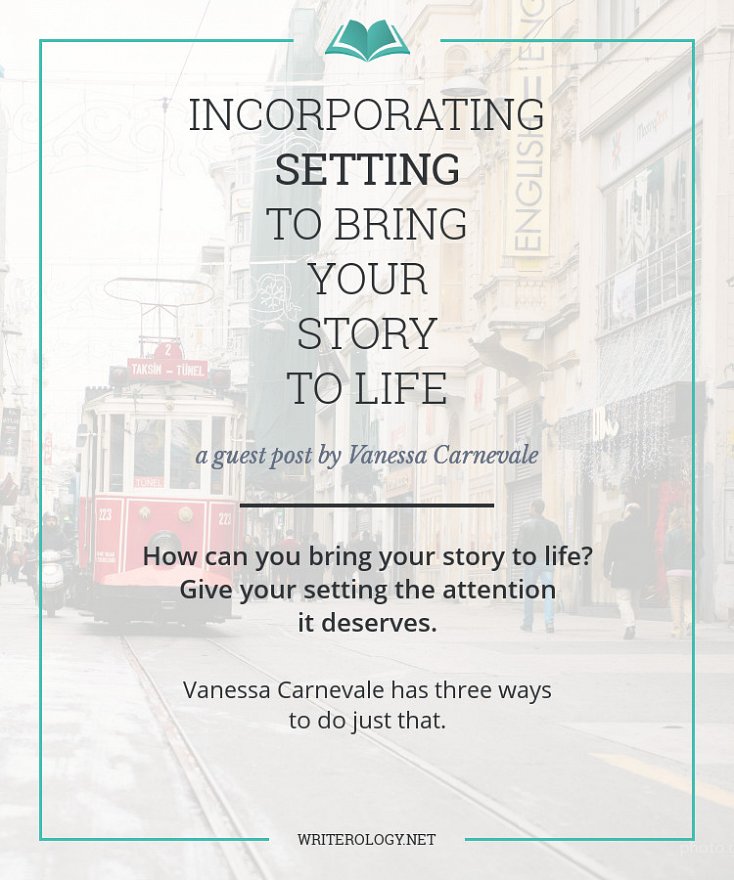Incorporating Setting to Bring Your Story to Life
How can you bring your story to life? Give your setting the attention it deserves. Vanessa Carnevale, my lovely guest today, has three ways to do just that. Take it away, Vanessa.

Some of my favourite books are ones that incorporate a strong sense of place. That is, books that wouldn’t be the same if they weren’t set where they were. There’s part of me that gets slightly disappointed when I pick up a book and find that setting has been neglected as a wonderful tool to bring added richness and an extra dimension to a story.
So how do we actually do this? How do we bring setting to life in a story?
Think about how the setting relates to your story
Setting can relate to the overall picture—where the novel is set, or to individual scenes of which there are many. If we take a look at the bigger picture first, consider how your setting relates to the actual story itself. How is the setting significant? How does the setting affect the characters? How does it shape them or determine the boundaries of their actions and the choices they make?
One of my favourite books of all time, The Help by Kathryn Stockett, is set in Jackson, Mississippi, during the early 1960’s. While there was a specific choice behind the time and place of this novel, from the very start the reader is grounded in this particular time and place. Not only did the writing completely transport me into that world in a really authentic way, but the culture, dialogue and characterisation are all affected by the setting in which this novel is set. Another novel worth looking at is The Signature of All Things by Elizabeth Gilbert, where her characters travel across the globe.
When we consider the settings for individual scenes, it’s worthwhile putting some thought into the choices you make for each scene. What is going to make your scenes memorable? Certainly the action and dialogue between characters will, but what if you can go deeper by ensuring that the setting is also working for you in terms of creating the kind of scene where the reader feels completely present and transported into your world? The weather can form part of the setting too, so consider how that might add to the atmosphere and tone of a particular scene. Is it snowing outside? Cold and windy? Hot and stuffy? How does this affect your character’s mood?
Incorporating setting into your writing
As with many other aspects of writing, often it’s the smallest details that can have the most impact. Here are some ways you can go about including details into your writing to help you bring setting to life.
ACTION
Some settings will allow you to have your character be present in a scene while interacting with it. Take a male character who lives on a farm. What might this character be tinkering with as a car pulls up the driveway? What might he be sipping on (and how might that be relevant) as he leans back into his chair on the porch while having a conversation with someone?
THE FIVE SENSES AND NOTICING THE SMALL DETAILS
Laura Deutsch, in her book Writing from the Senses, offers some great tips and insights into how to incorporate the five senses into your writing. My best tip here is to stop for a moment and visualise yourself in the room with your characters. Ask yourself what you’re seeing, feeling and hearing. Notice the expressions of your characters as well as the small things, such as the lighting, the hum of the refrigerator, the sound of the rain forming puddles in the mud outside. By practicing mindfulness in real life on a daily basis, you can bring this skill of deep noticing to your writing.
MAKE IT MEMORABLE
What memorable qualities do your descriptions have? What images and actions are going to stay with the reader once they put the book down? And just as importantly, consider whether your descriptions provide any hints towards the meaning of the story. To do this, you might like to consider the themes of the story, so when you’re writing description and making choices about setting, you can offer subtle hints as to how it relates to the actual story itself.
Play around with your setting
You can check in with how setting is working for you by asking yourself how the scene might read if it were set somewhere else. Are you inspired by the setting? Do you feel like you’re there in the room with the characters, or do you feel like you’re experiencing this scene as a detached observer? What tweaks can you make to bring things to life and make your reader feel like they’re there, in those scenes with your characters?